
Although the scope for replacing oil with plant-derived fuels is limited,
energy crops could readily produce a tenth of Ireland's total energy
demand without seriously curtailing other types of agricultural production.
But financial incentives will be needed to make this happen.
Although farm-based renewable energy production
is the main theme of this paper, three other
energy-related issues need to be addressed too.
First, the agricultural sector is a major source of
greenhouse gas and acid-precursor emissions,
and it must expect to come under increasing
pressure to reduce these. Second, the cost of the
energy input on farms is increasing rapidly,
with consequent financial problems for an
industry in which profit margins are already
tight. Finally, the need to abate national greenhouse
emissions may open up opportunities for
the use of crops, by-products and wastes for
renewable energy production.
This paper will therefore review the position
under three headings:
The new millennium brought a number of forecasts
of the changes that might be expected in
Irish agriculture over the next 10 to 15 years.
These forecasts reflect the likely impact of factors
such as input costs, production technologies,
labour cost and availability, market forces,
environmental constraints and expected EU
agricultural policy. Major changes in the structure
of the industry have been forecast, with a
much reduced number of much bigger holdings
engaged in intensive farming alongside an
increased number of small extensive units
farmed part-time or in niche activities.
However, to date no major changes in the enterprise
mix have been predicted (Downey 2000,
Donnelly & Crosse 2000). Adjustments to the
Common Agricultural Policy may eventually
provide the impetus for a move from livestock
to non-food production.
The expectation of major structural change,
along with the problems caused by BSE and
foot-and-mouth disease and the lack of profitability
in many enterprises, have led to a fall
in morale among farmers. While there is a
widespread recognition of the need for new
enterprises, the finance and commitment needed
to make the transition may be in limited supply.
Of Ireland's total land area of 6.9 Mha, at present
almost 5 Mha is used for agriculture and
forestry. Of this, about 0.5 Mha is rough pasture
suitable only for low-intensity grazing. The current
use of the remaining land is grassland 3.5
Mha, forestry 0.65 Mha and arable crops 0.4
Mha.
The total energy input to agriculture can be
divided into that which is used directly (i.e fuel,
electricity) and that which is used indirectly to
produce farm inputs (e.g. feedstuffs, fertilisers,
plant protection products).
2.1 Direct energy use: Data from the Teagasc
Irish Farm Survey indicate that Irish farmers
purchased about 258 kt (258,000 tonnes) of oil
in 2001 at a total cost of about €140M
(Figure 6A1).
1. INTRODUCTION
2. ENERGY INPUT TO AGRICULTURE

Apart from a small amount (possibly 5 kt) used for grain drying, this was used predominantly in the engines of tractors and self-propelled machines. Of an additional €126M spent on road vehicle fuel (mainly petrol), €46M was attributed to farming operations. This is equivalent to about 50 kt of fuel.
The Teagasc survey does not include the fuel
that was used by farm contractors. An approximate
breakdown of on-farm energy consumption
by operation, based on estimates of agricultural
production and fuel consumption from
various sources as well as Oak P ark experience,
is given in Figure 6A1 (O'Kiely et al 2000,
Pellizi et al 1995, Postoven & van Daspelaar
1994, Wegener et al 2002). Since most silagemaking
as well as some arable crop operations
and slurry spreading are carried out by contractors
(Figure 6A2), this could bring the total fuel
use on farms up to between 370 and 400 kt at a
cost of €220-€240M.
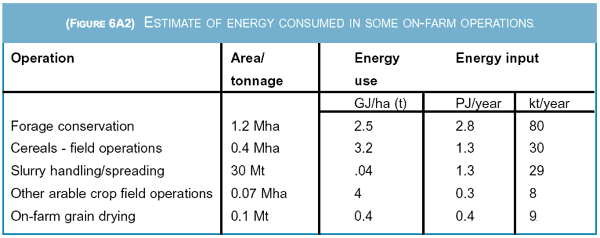
In the National Energy Balance (Dept of Public Enterprise website), 278 ktoe (kt of oil equivalent) was attributed to agriculture in 2001. This equates to 269 kt of diesel oil. The Central Statistics Office (CSO) website included in its estimates of inputs to agriculture a total of €298M spent on energy and lubricants. Excluding the expenditure on electricity (€74M) and lubricants (€7M), it is estimated that a total of €217M was spent on fuel oils. Both these estimates are in reasonable agreement with the Teagasc survey results.
Apart from fuel oil, the other significant direct energy use on farms is electricity. This is estimated at 52 ktoe in the National Energy Balance for 2001 and €74M in the CSO input estimates. In the Teagasc survey, farmers indicated that €38M (equivalent to about 30 ktoe) of their expenditure on electricity should be attributed to their farming operations. The discrepancy between these estimates stems from the difficulty in separating farm from domestic use.
The total direct energy input on farms is therefore between 400 and 450 ktoe, or between 18 and 20 PJ. This is about 3% of total final consumption in Ireland, so any reductions that might be achieved in agriculture would have little impact on the total consumption figure. Nevertheless an effort to achieve some reduction in on-farm energy consumption is worthwhile, to improve the profitability of operations that are under severe financial pressure as well as to reduce the contribution from agriculture to greenhouse gas and acid-precursor emissions.
According to the estimates in Figure 6A2, silage-making, tillage operations and slurry handling/spreading are the operations requiring most of the direct energy input. Efforts to reduce the use of energy in field operations can be tackled under the following headings:
While research and advice can contribute to some efficiency improvements, it has to be acknowledged that the likelihood of achieving large improvements in the present economic climate is not great. At present, farmers' machinery management decisions are primarily concerned with reducing overhead costs and labour. In some cases this may lead to more efficient fuel use e.g. the hire of a contractor with new, efficient equipment. In other cases it may have a negative effect e.g. extension of machine replacement intervals.
Given that there is likely to be a slight reduction in animal numbers, and some diversion of land out of agriculture into forestry, amenity and building development, as well as some improvement in energy efficiency, a reduction of 15-20% in direct energy input to agriculture would appear to be a reasonable target for the next 5 years. In the longer term, a continued gradual reduction is the most that could be expected.
2.2 Indirect energy use: The major indirect
inputs of energy into farming are in the form of
animal feeds (mainly imported protein), mineral
fertiliser, crop protection products and veterinary
products. From an energy viewpoint, fertiliser
use is the most interesting. Figure 6A3
shows that nitrogen (N) is the dominant factor
linked to energy, and that fertiliser energy input
is similar in magnitude to direct energy use
(Postoven & van Daspelaar 1994).

In addition
to this energy input, N application also contributes
to ammonia and N20 emissions from
the soil, as well as to the leaching of nitrates to
watercourses. So a reduction of N use would
have significant benefits for agriculture, provided
it could be achieved without loss of crop
yield. Possibilities for achieving this will be
discussed later.
In relation to current farming, input reduction is
the most direct way of reducing emissions. In
particular the reduction of N fertiliser would
reduce N20 emission as well as energy input.
Farmers need to be persuaded not to exceed
recommended fertiliser rates. REPS-type programmes
and legislative controls will make a
contribution in this direction. In the medium
term, research will be directed at improving the
precision of recommended rates and timings,
backed up by the use of decision-support systems.
Looking further ahead, techniques for
variable-rate application in response to yield
maps and soil analysis, will help to make more
effective use of reduced amounts of fertiliser.
Taking all the above into account, a reduction
of 10% in the total amount of fertiliser used
might be considered an achievable target for
the next five years, with a further reduction at a
similar rate in subsequent years.
Another approach to the reduction of mineral
fertiliser input is to achieve a greater substitution
of mineral nutrients by animal manure. At
present about 400 kt of N is applied in mineral
form in Ireland; about half that amount is present
in the animal slurry collected on farms
(Dept of Agriculture web-site). When farmers
are choosing fertiliser application rates, they
make little allowance for the N that is present in
the slurry, for two reasons. First, an unknown
amount of it is lost in conventional splash-plate
spreading. Second, the rate at which the slurry
N becomes available to the growing crop is less
certain than that of mineral N. The first problem
could be greatly eased by the use of a low-emission
spreading technique, the second could be
improved by anaerobic digestion which would
make slurry N availability faster and more predictable.
If some progress can be made in the introduction
of these technologies, a 10% increase in the
substitution of mineral N by slurry N over the
next five years should be attainable.
3.1 Greenhouse gases Global warming is set to
become a major international issue over the next
ten years. Ireland's allocation of a 13% increase
in GHG in the period from 1990 to 2008-12 was
reached in 1998, and an increase close to 30%
is feared unless corrective action is taken. The
achievement of the 13% target will require that
every possibility for CO2 abatement be fully
exploited.
With regard to agriculture, it is reasonable to
ask:
The agricultural sector accounts for 35% of
greenhouse gas emissions (Figure 6A4,
Convery & Roberts 2000, Environmental
Resource Management 1998).
3. GREENHOUSE GAS AND ACID-PRECURSOR
EMISSIONS
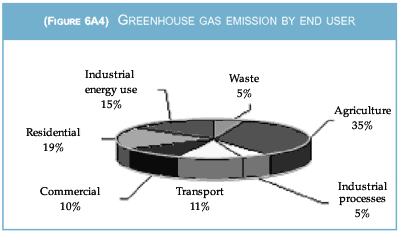
This high ratio arises from our big livestock industry, most of whose production is exported. Whatever the reason, efforts to reduce emissions will inevitably focus on the farming sector. Agriculture differs from the other sectors in that it also affects the amount of CO2 that is recycled by growing crops, and the amount that is stored in soil and over-ground biomass.
Of the approximately 24 Mt of CO2 equivalent
emissions attributed to agriculture, the major
contributors are as in Figure 6A5.
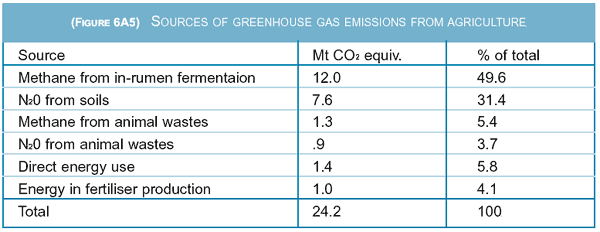
These figures are taken from the ERM report (Environmental Resources Management 1998), with the addition of the CO2 estimated to be associated with direct and indirect energy use on farms.
Methane from in-rumen fermentation can only be tackled by reducing animal numbers or altering their diet. While some reduction in animal numbers may be expected, a large reduction would have serious economic consequences. Diet adjustment would be very difficult to achieve in a largely grass-based industry.
N20 from soils is very difficult to estimate. It
would be reasonable to assume that a reduction
of N fertiliser would lead to a reduction of N20
emissions, though the extent of the reduction is
difficult to predict. This leaves us with the lesser
items; N20 and methane from animal wastes,
as well as direct energy use and N fertiliser.
3.2 Acid-precursor emissions: In parallel with
the Kyoto agreement on greenhouse gases, the
Gothenburg Protocol binds Ireland to reductions
in acid-precursor emissions over the same
1990-2010 period (United Nations 1999). From
the viewpoint of agriculture, ammonia is the
main concern, since 90% of ammonia emissions
come from agriculture. Agriculture
accounts for a much smaller proportion of NOx
emissions, but some reduction of the agricultural
contribution would still be of value.
The Gothenberg Protocol requires a 9% reduction
of national ammonia emissions (United
nations, 1999). Of the total of about 120 kt of
ammonia emitted from farms, that from pasture
would be almost impossible to reduce by any
means other than a reduction of animal numbers
(Figure 6A6).
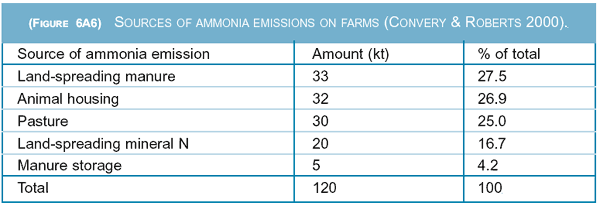
Emissions from animal buildings and manure stores would be difficult and expensive to control. The main targets for reduction should be those from the application of mineral fertiliser and from the spreading of animal manure, which account for about 44% of the total.
Of the other acid-precursor emissions, NOx is directly related to combustion. NOx emissions from new and lightly-used tractors in Sweden and Switzerland have been reported at 5 to 15 g/kW h, or 0.42 to 1.27 kg/GJ at 30% engine thermal efficiency (Hannson et al 2001, Rinaldi & Stadler 2002). The US EPA has reported on its web-site average NOx measurements in a tractor fleet of 8.4 g/hp h (equivalent to 11 g/kW h or 0.93 kg/GJ). The Danish RISO National laboratory website lists a NOx emission factor of 1.28 kg/GJ for use with off-road diesel vehicles. This is somewhat higher than the other estimates, possibly because it includes off-road vehicles other than farm tractors which may have longer idling periods. McGettigan & Duffy (2000) have quoted an emission factor for off-road vehicles of 1.15 kg/GJ. If this is applied to an annual fuel consumption of 320- 350 kt, NOX emissions would be about 18 kt. The emissions from the small amount of fuel used in heating/drying would be insignificant. For road vehicles, applying a lower emission factor (0.5 kg/GJ) to the combustion of 50 kt of fuel would give about 1 kt of NOx emissions. This suggests that the total emission of NOx from on-farm fuel use is about 19 kt.
This estimate is considerably higher than the 4.5-5 kt published elsewhere (Curtis 2001, Environment Protection Agency 2001). The difference arises mainly from confusion about the proportion of farm fuel purchases that is used in engines.
Potential for emission reduction:
Anaerobic digestion of slurry would allow the methane to be harnessed for energy use, and thus achieve a double benefit. A recent UK life-cycle analysis has estimated that anaerobic digestion of pig slurry has the potential to reduce emissions by the equivalent of 144 kg of CO2 per tonne of pig-meat produced (Cumby et al 2000). On this basis, 75% adoption by the pig sector in Ireland would reduce emissions by 16 kt CO2 per year. A high adoption rate may be achievable in this sector as the technology would fit in easily on the large centralised units that now make up most of the industry. Also these units are having increasing difficulty finding land nearby for land-spreading, and the smells from slurry transport and spreading are becoming an increasing problem.
The technology would also be applicable to the dairy industry, but is likely to have a much slower uptake. Units are smaller, smells are less of a problem, and to date on most farms the land bank is adequate to take all the slurry. A 10% adoption would abate about 60 kt CO2 per year. The beef sector has had so many recent problems and is generally so unprofitable that it is difficult to envisage investment in anything but the most essential items in the near future.
If digestion could be introduced at the above projected levels over the next five years, a total of about 80 kt/year of CO2 could be abated. An Irish Bio-energy Association report estimates that the total potential for CO2 abatement by digesting all animal manures is 5Mt/year (Irish Bio-energy Association 2000).
A reduction of mineral N usage, or a transfer from urea to ammonium nitrate, would bring about some reduction in the associated ammonia emission. But the main possibility to achieve a substantial emission reduction is to use a low-emission slurry spreading system. Reductions of up to 50% could be achieved with a simple band-spreading technique. If 50% of animal manure were spread with this system, most of the required 9% reduction of ammonia emissions could be achieved.
The main limitation to the adoption of low-emission spreading techniques is the need to improve machine design and all stages of slurry collection and storage and agitation to avoid blockages. The extra cost of spreading would also be a deterrent, and farmers may be expected to continue with the present splash-plate system until they perceive some financial advantage in changing.
In summary, a combination of low-emission slurry spreading systems and slurry digestion could achieve a combination of useful objectives:
On this basis, a substitution of 10% of the applied mineral N by slurry N might be achievable over a five-year period.
A quick reduction of NOx emissions from agriculture would be difficult to achieve. The fall in fuel use projected in Section 2.1 would bring a corresponding reduction in NOx emissions. In the long-term, a 3-tier schedule of regulatory emission controls aims to halve NOx emissions on new off-road engines by 2010. In the interim, the methods that might be considered to achieve a more immediate reduction of NOx emissions would be:
Many difficulties could be foreseen in the implementation of either action.
4.1 Overall potential: The total potential for
energy production from agriculture can be estimated by adding the potential from energy
crops to that from by-products of existing enterprises.
From crops converted by some form of
combustion to heat, an energy yield from 100 to
200 GJ/ha might be achieved, depending on the
crop selection, land quality etc. Assuming that
an average energy yield of 125 GJ/ha could be
achieved, the current set-aside area could produce
about 4 PJ, or 11% of the total agricultural
energy demand. To achieve, say, 10% of
national primary energy requirement from biomass
crops, an area of over 0.5Mha would be
required, i.e. more than the current arable area
(Fig. 6A7). At the extreme, the total Irish land
resource could just about produce our national
primary energy requirement.
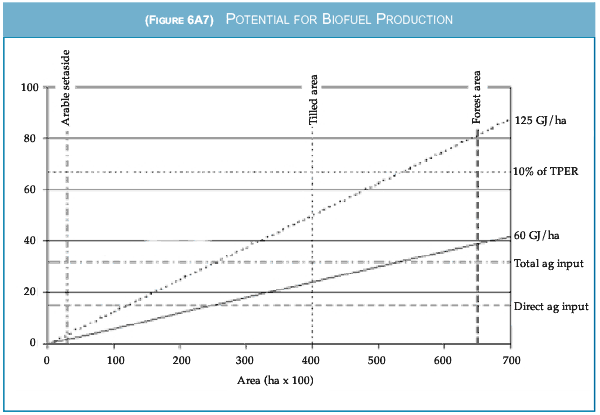 |
Crops grown for liquid biofuel production (e.g. rape-seed for biodiesel, cereals or beet for ethanol) would produce a lower amount of energy, probably about 60 GJ/ha. Crops for these purposes are more likely to be annual arable crops. If the full arable set-aside area were devoted to them, it would produce about 1.8 PJ, or 40 ktoe, i.e. about 15% of the agricultural fuel requirement. To supply the full agricultural fuel oil need would require almost all the current arable area to be devoted to it.
The main by-product materials that could make
a contribution are as in Figure 6A8.

Some of these materials (e.g. molasses, some straw) have existing markets which underpin their price; others have more limited outlets. Also materials such as slurry from small dry-stock units could hardly be utilised economically, and forest residues would be better left in situ on many sites. A rough estimate of the volumes that might be available at a reasonable price and the amount of energy they might produce is also given in Figure 6A8.
4.2 Biofuel technologies: Of the many possibilities for producing biofuels from farm produce, three of the more likely possibilities for Ireland are considered here:
4.2.1 Biogas from animal slurry: This has already been discussed in detail. If the targets mentioned for slurry digestion were achieved (i.e 10% of dairy slurry and 75% of pig slurry digested), about 10 MWe of electricity could be generated from the biogas produced. This is a much more conservative estimate than that of the Irish Bio-energy Association (IrBEA), who suggest that 250 MWe could be produced from biogas (IrBEA, 2000).
4.2.2 Oils and fats as heating or diesel engine
fuels: Vegetable oils and animal fats can provide
a source of renewable fuel, either for diesel
engines or heating systems. Some of these uses
are already well developed, others are still
under development (Fig. 6A9).
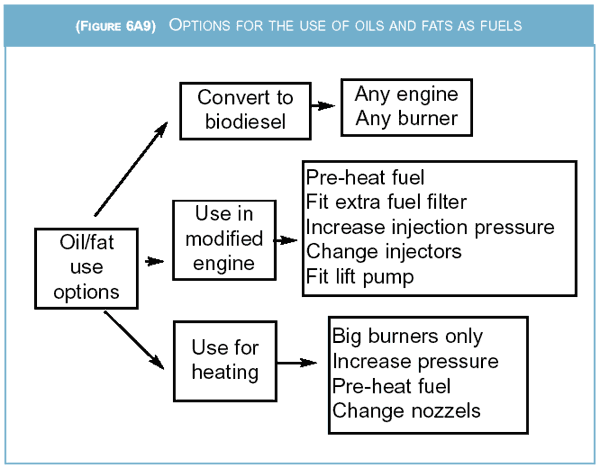
Any of these uses would reduce CO2 emissions by over 3 tonnes per tonne of fuel used. Also these fuels have no sulphur, which improves exhaust emissions, and they are biodegradable, which reduces pollution risks from spillages. These materials could never replace more than a small fraction of the mineral diesel requirement. They should be seen instead as premium fuels whose use should be directed to applications that make best use of their health and environmental advantages.
Oils and fats can be used as engine fuels in two ways:
1. In unprocessed form, with some peripheral modifications to the engine. This use is relatively new but developing rapidly in Germany; engine conversion kits are on sale and are working very well. The conversion consists of some combination of fuel pre-heating, extra filtration, increased injection pressure and replacement injectors. More information on exhaust emissions is needed. Fuel processing cost and industry start-up costs are kept to a minimum. This approach would have particular relevance in Ireland; it needs a low capital investment, the by-product cake can be used locally, and it is possible to start small and expand later.
2. Converted into biodiesel and used in any engine without modification. This use is widely accepted and supported by the vehicle industry. Also the fuel has been proven to emit less particulates and smoke than mineral diesel. This reduces the harmful effects of exhaust emissions in cities. About 1Mt/yr is produced and used in the EU. It requires substantial plant investment, and processing adds about 5-10 cents/litre to the final cost of the fuel.
The use of these fuels for heating in large-scale burners is technically feasible, but economic viability depends on a very low raw material price, competitive with heavy-grade mineral oil. Use in domestic-scale heating units would be more economical, but the availability of suitable burners at a reasonable price remains a problem.
Currently, the main fuel use of oils/fats in the EU is biodiesel produced from crops grown on set-aside land: mainly rape in N. Europe, with some sunflower in the south. Oil-seed crops grown on set-aside in Ireland would also provide as a by-product a native source of GM-free animal feed protein, which would find a ready market. Ireland has about 30,000ha of set-aside; if two-thirds of this could be brought into oilseed production, it would provide about 20 kt of fuel oil and 40 kt of oil-seed cake.
A cheaper raw material is recycled vegetable oil (RVO) oil from caterers. The use of this material in animal feeds has been disrupted since the 1999 Belgian dioxin-in-chickens incident, which was traced to RVO. If no alternative use is found in the Republic, two possibilities arise:
Up to 10 kt/year could be collected. Oak Park research, together with research and practical experience in Austria, is showing that it can be used to make good quality biodiesel.
Beef tallow, whose market as an animal feed has been disrupted by BSE, is another possibility. The disposal of tallow from the rendering of BSE-risk offals (ca. 3000t) has been resolved by its use in boilers in rendering plants. Total tallow production is about 60 kt, two-thirds of which goes to animal feed. The long-term future of tallow as animal feed is in some doubt, and alternative outlets are very desirable. Its use for heating is already being demonstrated, but a transport use would have a higher value.
Biofuel technologies are still relatively new. While the price difference between them and fossil fuels has narrowed significantly in recent years, they still need some pump-priming support in the early stages of competition with fossil fuels. Present costs vary from about 30 cents/litre for clean RVO used unprocessed to 55-65 cents/litre for biodiesel from fresh rapeseed oil. This compares with about 30-40 cents/litre for mineral diesel before excise, VAT and distribution costs.
Subsidy for biofuels could be justified on many grounds:
Some EU member states (e.g France, Germany, Italy, Austria and Spain) promote vehicle biofuel production by reducing road excise. This support mechanism is permitted by the EU. The Scandinavian countries promote all forms of biofuel use by means of their carbon tax regimes. In the UK, a remission of 20p/litre on biodiesel was introduced in 2002. At this stage, virtually all of Europe except Ireland has some form of support for vehicle biofuels. The UK measure is likely to stimulate considerable biodiesel production, and in the absence of similar action here, a cross-border traffic in feedstocks is likely to develop.
The EU is now considering proposals from the Transport Directorate to oblige member states to achieve target substitution rates of mineral fuels by their equivalent biofuels. The targets proposed begin with 2% by December 2005, extending to 5.75% by 2010. To meet the 2% target on the diesel side, Ireland would need to use 70kt of oils/fats as vehicle fuel. This would be very difficult to achieve. A possible combination of feedstocks would be as follows:
This would supply most of the buses and taxis
in Dublin. If the fuel were used in this way it
would achieve the following:
Reduce sulphur emissions, and consequent
acid rain damage to buildings
At a similar level of support to the proposed UK excise remission, the maximum cost to the exchequer would be 15M euro/yr. The combination of all the benefits from the project would well out-weigh this cost. Unlike the UK proposal, the support should be provided for any use of vegetable oils or animal fats as vehicle fuels. The market could then dictate which technologies are most appropriate in Ireland.
4.2.3 Ethanol as vehicle fuel There are two likely ways in which ethanol could be used as fuel for spark-ignition engines in Ireland:
(i) Petrol-ethanol blends may be used in conventional unmodified spark-ignition engines. An EU directive permits the use of up to 5% ethanol in blends with petrol (Commission of European Communities, 1985). This approach is widely used in the US, but has not been favoured in the EU, due to technical problems with the handling and storage of the fuel, caused by its solubility in water and high vapour pressure.
(ii) Blends of the ethanol derivative ETBE (ethyl tertiary butyl ether) and petrol may also be used in unmodified engines. The 1985 directive authorises up to 15% ETBE in blends. This has been the most favoured approach to ethanol use in the EU. ETBE can replace MTBE as an octane enhancer in lead-free petrol. MTBE is in the process of being banned from this use in California, due to the contamination of water supplies by exhaust emissions. If this trend becomes widespread, it would stimulate the demand for ETBE. A problem in Ireland would be the additional plant requirement for the conversion of ethanol to ETBE.
A Teagasc review has dealt with this subject in
detail (Rice et al 1997). Total production costs
have been estimated for conventional and lignocellulosic
materials in tables 6A10 and 6A11
which show a range of production costs from 47
to 73 cents/litre, depending on the feed-stock
materials, feed-stock price and transformation
process.

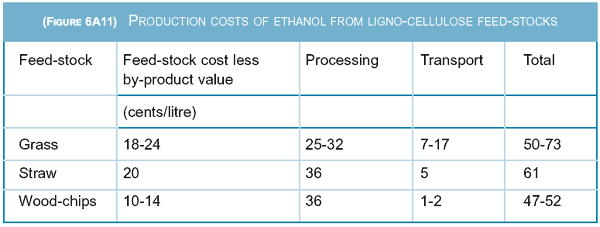
Ethanol has a calorific value about two-thirds that of petrol. On this basis, its value as a petrol replacement, before tax or distribution cost, is less than 25 cents/litre. A comparison with the price of methanol, based on its octane-enhancing properties, would give it a similar value. Even a full remission of road excise would make only the lowest-cost wood-chip scenario competitive; further economies would have to be achieved to reduce costs with all the conventional conversion systems.
The main advantage of ethanol production as an outlet for arable crops is that it can be produced from such a wide range of feed-stocks, many of which are already being grown, so the technology for production, harvesting, drying and storage is already in place. If used as an additive to petrol, a distribution and marketing system is also in place, so the process plant is the only additional requirement.
In spite of the apparently unfavourable economics of bio-ethanol production to date, it has become well established in the US, where production is stimulated by the need to oxygenate mineral fuels to comply with clean air legislation. Current US long-term projections are for an industry producing large volumes of bioethanol from low-cost by-product or residue ligno-cellulose materials at a cost approaching that of petrol. The long-term availability of suitable raw materials in Ireland, and the benefit of a low-value outlet for by-product or residue ligno-cellulose materials, needs to be further evaluated.
Ethanol production from sugar beet merits special consideration because of its potential synergistic relationship with the existing sugar industry. Facilities are already in place for the organisation of crop production under contract, and for transport, reception, pre-cleaning and juice extraction; only the fermentation and distillation plant would need to be added.
Ireland currently plants about 35,000 ha of sugar beet. Land for the production of extra beet would be available; with sugar yields continuing to increase and at best a constant sugar quota, it would at least ensure that the area under beet would be maintained at current levels for the medium-term future. Sugar beet is a high-input crop; as well as creating a demand for farm labour and other inputs for the production of the crop, it also generates many spin-off benefits, such as animal feed supply, labour for haulage and processing, and local farm machinery production.
Beet for ethanol production would not be grown on set-aside land, so it would not compete for land with a vegetable oil industry. Teagasc estimates the variable costs of sugarbeet production for 2002 at 1462 Euro/ha (O'Mahoney, 2001). At the B-quota price of about 35 Euro/t, a yield of 42 t/ha would be required to recoup these costs. Given that this is close to the average yield, beet production at this price might be expected to have limited attraction for growers. However, other issues, such as the avoidance of outside-quota prices in high-yield years, would also play a part in farmers' decision-making.
A bio-ethanol industry would make only a small contribution to the reduction of CO2 emissions, as a result of the relatively large amount of energy used in processing.
The main advantages of bio-ethanol as an additive to petrol are:
(i) its oxygenating effect, leading to a reduction of CO in vehicle emissions and a reduced potential for ozone formation in the atmosphere.
(ii) its effect as an octane enhancer, as an alternative to lead compounds or MTBE.
(iii) the absence of sulphur.
(iv) reduction of hydrocarbons in the emissions.
Given that there is likely to be a slight reduction in animal numbers, and some diversion of land out of agriculture into forestry, amenity and building development, as well as some improvement in energy efficiency, a reduction of 15-20% in direct energy input to agriculture would appear to be a reasonable target for the next five years. In the longer term, a continued gradual reduction is the most that could be expected. A reduction of 10% in the N fertiliser input, with a corresponding reduction of indirect energy input, might also be considered an achievable target.
Since much of the greenhouse gas emissions
from agriculture are very difficult to control, the
scope for reduction is limited. Nevertheless,
some reduction is attainable. Figure 6A12 indicates
how a reduction of over 9% could be
achieved over the next five years.
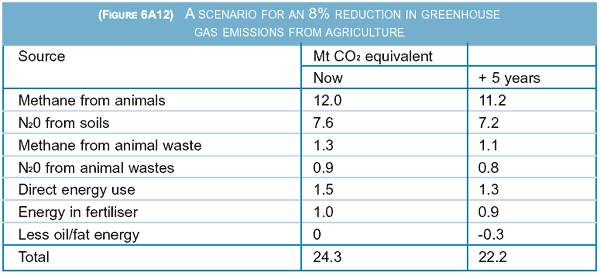
The reduction in methane from animals is projected
on the basis of a small reduction in animal
numbers. The reduction in N20 from soils
and in fertiliser energy would be achieved by a
reduction in mineral fertiliser use, which in turn
would be partly due to a fall in overall N application
and partly due to an increased substitution
of slurry N. The fall in direct energy input
would be mainly achieved by greater efficiencies
in machinery use. Finally, the production of
methane and the use of oils and fats as fuels
could contribute an abatement of up to 300 kt.
The reduction of N use in urea form and the
adoption of low-emission manure spreading
techniques could make up the required 9%
reduction in ammonia emissions. There would
be a synergistic effect from the simultaneous
introduction of digestion and low-emission
spreading; digestion would reduce blockages,
and full-width spreading should give more even
distribution and facilitate substitution of mineral
N.
The other benefits that would accrue from the
developments listed above would be:
In all these areas, technologies are now well
established and in practical use in other EU
countries. Such incentives as have been available
in Ireland to date to stimulate renewable
energy production have not been sufficient to
stimulate the establishment of viable projects.
To allow a beginning to be made, two changes
are needed immediately: a reduction or remission
of road excise on biofuels and an increased
price for electricity from biomass. Since the
size of the biomass resource is limited and no
exchequer costs are incurred until the renewable
energy is produced, these measures could
be introduced with very little risk to the economy.
This paper addressed three inter-linked problems
related to energy in agriculture:
Nitrogenous fertiliser (N) is the biggest indirect
energy input. With greater precision in N use,
and an increased substitution of slurry for mineral
N, a reduction of 20% over five years without
reducing output should be achievable.
With agriculture contributing over one-third of
national greenhouse gas emissions, pressures
for reduction must be expected as the effort to
achieve Kyoto targets intensifies. Some abatement
of ammonia emissions is also required to
comply with other international commitments.
To achieve both of these targets without reducing
output, digestion and low-emission spreading
of animal slurry to minimise methane and
ammonia emissions are the most promising
options.
If liquid biofuel crops (for vegetable oil or
ethanol) were grown on the existing set-aside
area, it could supply about 10% of the agricultural
fuel demand. To meet the full agricultural
fuel demand, an area of about 0.3Mha (6% of
the farmed area) would be needed.
Where the whole of an energy crop is utilised in
a heating or CHP plant, about 0.5Mha would be
required to meet 10% of the total national primary
energy demand. This could be set as a
medium-term target that could be achieved
without major disruption of the existing levels
of food and feed production. At the extreme, the
total farmed area could produce an amount of
energy roughly equivalent to our national primary
energy demand.
Waste or by-product materials such as wood
residues, straw, tallow and recovered vegetable
oil would produce relatively small amounts of
energy, but as reasonably-priced feedstocks
they could help get biofuel industries started.
Animal manures have a large potential, and
their digestion could play a key role in the
reduction of methane and ammonia emissions.
Digestion of all pig and some dairy slurry
should be a medium-term target.
The most promising technologies for the conversion
of farm biomass to energy are:
In all these areas, technologies are now well
established and in practical use in other EU
countries.
Convery, F., Roberts, S., 2000. Farming, climate and the environment in Ireland.
Cumby, T., Nigro, E., Sandars, D.L., Canete,C., Williams, A.G., Scotford,I.M., Audsley,E., 2000. The environmental impact
of farm scale anaerobic digestion of livestock wastes. Paper 00-AP-024, AgEng Conference, Warwick, July 2000.
Donnelly, L., Crosse, S., 1999. A perspective of the dairy industry 2010. Proc. Agri-food Millenium Conference. Teagasc, 19
Sandymount Ave, Dublin 4.
Downey, L., 1999. What will the agri-food industry look like in 2015?, Proc. Agri-food Millenium Conference. Teagasc, 19
Sandymount Ave, Dublin 4.
Environmental Resources Management, 1998. Limitation and Reduction of CO2 and other greenhouse gases in Ireland.
Government Publications Sale Office, Molesworth St., Dublin 2.
Hansson, P.A., Lindgren, M., Noren, O., 2001. A comparison between different methods of calculating average engine emissions
for agricultural tractors. J. agric. Engng. Res, 80,1:37-43.
Irish Bio-energy Association, 2000. Strategy for Anaerobic Digestion Development in Ireland. IrBEA, c/o Tipperary Institute,
Thurles, Co. Tipperary.
O'Kiely, P., McNamara, Forristal, D., K, Lenehan, J.J. 2000. Grass silage in Ireland. Farm and Food, Winter 2000, pp. 33-
38.
McGettigan, M., Duffy, P., 2000. Emissions to air 1990-1998. Environment Protection Agency, Johnstown Castle, Co
Wexford.
Pellizi, G., Cavalchini, A.G., Lazzari, M., (editors), 1989: Energy savings in agricultural machinery and mechanization.
Elsevier Applied Science Publishers, Crown House, Linton Rd, Barking, Essex 1G11 8JU, England.
Pothoven, R., van Dasselaar, A., 1994. Extensief kost energie: energieverbruik in de akkerbouw. Landbouwmechanisatie, 45
(6) 38-40.
Rice, B., Bulfin, M., Kent, T., Frohlich, A., Lenehan, J.J., 1997. Potential for Energy Production from Agricultural and Forest
Biomass in Ireland. Teagasc, 19 Sandymount Ave., Dublin 4.
Rinaldi,M., Stadler, E., 2002. Trends im Abgasverhalten landwirtschaftlicher Traktoren. Berichte 577/2002,
Forschungsanstalt fur Agrarwirtschaft und Landtechnik, CH-8356 Tanikon TG, Switzerland.
United Nations, 1999. Draft Protocol to the 1979 Convention on long-range transboundary air pollution to abate acidification,
eutrophication and ground level ozone. ECE/EB.AIR/1999/1. UNECE, Geneva.
Wegener, U., Koch, H.-J., and Miller, H., 2001. Effect of long-term reduced tillage on the energy balance of sugar beet and
winter wheat crops, Proc. 65th Congress International
This is one of almost 50
chapters and articles in the 336-page large format book, Before the Wells
Run Dry. Copies of the book are available for £9.95 from Green Books. Continue to Part B of Section 2: Sustainability through Local Self-Sufficiency
6. SUMMARY
Engine fuel (almost 0.3 Mt) is agriculture's
main direct energy input. Since there is likely to be a slight reduction in animal numbers and
some diversion of land out of agriculture, as
well as some improvement in energy efficiency,
a reduction of 15-20% in this input over the
next five years would appear to be a reasonable
target. In the longer term, a continued gradual
reduction is the most that can be expected.
REFERENCES
